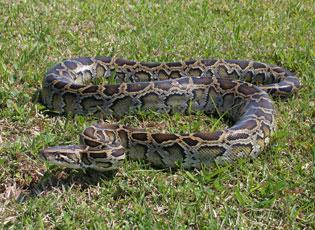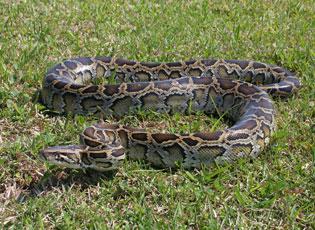The Burmese python is a fascinating and widely known species of snake. It is one of the largest snakes in the world, with some individuals growing up to 23 feet in length! But have you ever wondered where this impressive creature comes from? In this article, we will explore the natural habitat and distribution of the Burmese python, and learn about its fascinating history and characteristics. So, let’s dive in and discover where the Burmese python is native to!
The Burmese Python is native to Southeast Asia, including Thailand, Vietnam, and Myanmar (formerly known as Burma). It can also be found in other parts of the world as an invasive species, such as in the Florida Everglades.

Where is the Burmese Python Native to?
The Burmese python is one of the largest snake species in the world, and is native to Southeast Asia. It is commonly found in countries like Myanmar, Thailand, and Indonesia. In recent years, Burmese pythons have become popular pets, and have been introduced to other parts of the world, including the United States. However, this has led to concerns about their impact on local ecosystems.
Native Habitat
Burmese pythons are primarily found in tropical and subtropical habitats, such as rainforests and marshes. They are known for their ability to adapt to a variety of environments, and can be found in both wet and dry regions. In their native range, they are an important part of the ecosystem, acting as both predator and prey.
Behavior
In the wild, Burmese pythons are typically solitary animals, although they may come together during mating season. They are excellent swimmers and are often found near water sources. They are also known for their ability to climb trees, and have been observed high in the branches of rainforest trees.
Appearance
Burmese pythons are large, muscular snakes that can grow up to 23 feet in length and weigh over 200 pounds. They are typically brown or yellow with dark blotches along their backs. They have a triangular head and powerful jaws that allow them to swallow prey whole.
Introduction to the United States
Burmese pythons were first introduced to the United States in the 1980s, primarily as pets. However, some pythons were released into the wild or escaped captivity, and began to establish populations in the wild. Today, Burmese pythons can be found in the wild in Florida, where they are considered an invasive species.
Impact on Ecosystems
Burmese pythons have had a significant impact on the ecosystems of Florida. They are top predators in their new environment, and have been known to prey on a variety of native species, including birds, mammals, and reptiles. This has led to declines in some native populations, and has disrupted the balance of the ecosystem.
Control Measures
Efforts are underway to control the population of Burmese pythons in Florida. This includes trapping and removal programs, as well as public education campaigns to discourage the release of pet pythons into the wild. While it may be difficult to completely eradicate the species from Florida, these efforts are aimed at minimizing their impact on the ecosystem.
Burmese Pythons as Pets
Despite their impact on ecosystems, Burmese pythons remain popular as pets. However, owning a large snake like a Burmese python requires a significant amount of responsibility and care.
Benefits of Ownership
Burmese pythons can make fascinating and rewarding pets for experienced reptile keepers. They are intelligent and can be trained to recognize their owners, as well as respond to certain cues. They also have a long lifespan, with some individuals living over 20 years.
Challenges of Ownership
Owning a Burmese python is not for everyone. They require a large enclosure, adequate heating and lighting, and a specialized diet. They can also be dangerous, especially if they are not properly handled or housed. In addition, it is important to consider the potential impact of releasing a pet python into the wild if it becomes too large or difficult to care for.
Conclusion
The Burmese python is a fascinating and complex species, with a rich history and important role in its native ecosystem. As they continue to spread to other parts of the world, it is important to consider their impact on local ecosystems and to take steps to minimize negative effects. For those interested in owning a Burmese python, it is important to do research and ensure that they are prepared to provide the specialized care that these snakes require.
Frequently Asked Questions
Here are some commonly asked questions about the Burmese Python’s native habitat:
What is the Burmese Python?
The Burmese Python is a large, nonvenomous snake that is native to Southeast Asia. It is one of the largest snakes in the world, growing up to 23 feet in length and weighing over 200 pounds. Burmese Pythons are known for their beautiful coloration and are often kept as pets despite their size.
However, the species has also become a major problem in Florida, where it was introduced as an invasive species and has been wreaking havoc on the ecosystem.
Where else can the Burmese Python be found?
Burmese Pythons are native to a wide range of habitats throughout Southeast Asia, including southern China, Vietnam, Thailand, and Indonesia. They are commonly found in forests, grasslands, and marshes, and are also known to inhabit agricultural areas and even urban environments in some cases.
In addition to their native range, Burmese Pythons have also been introduced to several other areas around the world, including the United States and parts of Australia. These introductions have led to serious ecological problems in some cases.
What is the habitat of the Burmese Python?
The Burmese Python is a highly adaptable species that is capable of living in a wide range of habitats. In its native range, it is commonly found in forests, grasslands, and marshes, and is known to inhabit agricultural areas and even urban environments.
When kept as pets, Burmese Pythons require large enclosures with plenty of hiding places and climbing structures. The temperature and humidity levels in their enclosure must also be carefully controlled to ensure their health and well-being.
Why are Burmese Pythons considered an invasive species in Florida?
Burmese Pythons were introduced to Florida as a result of the exotic pet trade, and have since become a major problem in the state. They have no natural predators in the area, and as a result, their population has exploded and they have been wreaking havoc on the local ecosystem.
They are known to prey on a wide range of native species, including birds, mammals, and reptiles, and have been shown to have a significant impact on the populations of these species. Efforts are currently underway to control the population of Burmese Pythons in Florida and prevent further damage to the ecosystem.
How are Burmese Pythons affecting the ecosystem in Florida?
The introduction of Burmese Pythons to Florida has had a significant impact on the local ecosystem. They are known to prey on a wide range of native species, including birds, mammals, and reptiles, and have been shown to have a significant impact on the populations of these species.
They also compete with native species for resources such as food and habitat, and can alter the ecosystem in ways that can have long-term effects. Efforts are currently underway to control the population of Burmese Pythons in Florida and prevent further damage to the ecosystem.
Largest Burmese python in Florida history discovered in the Everglades
In conclusion, the Burmese python is a fascinating and often misunderstood creature. While it is now found in many parts of the world, including the United States, it is native to Southeast Asia. Specifically, it can be found in countries such as Myanmar, Thailand, and Vietnam.
Despite its reputation as a dangerous predator, the Burmese python plays an important role in its ecosystem and is valued by many cultures for its meat and skin. However, due to habitat loss and overhunting, this species is facing significant threats and has been listed as vulnerable by the International Union for Conservation of Nature.
It is important to continue researching and protecting the Burmese python, not only for its own sake but also for the sake of the many other species that depend on it. By understanding the origins and behavior of this remarkable snake, we can work to ensure its survival and the health of our planet as a whole.


